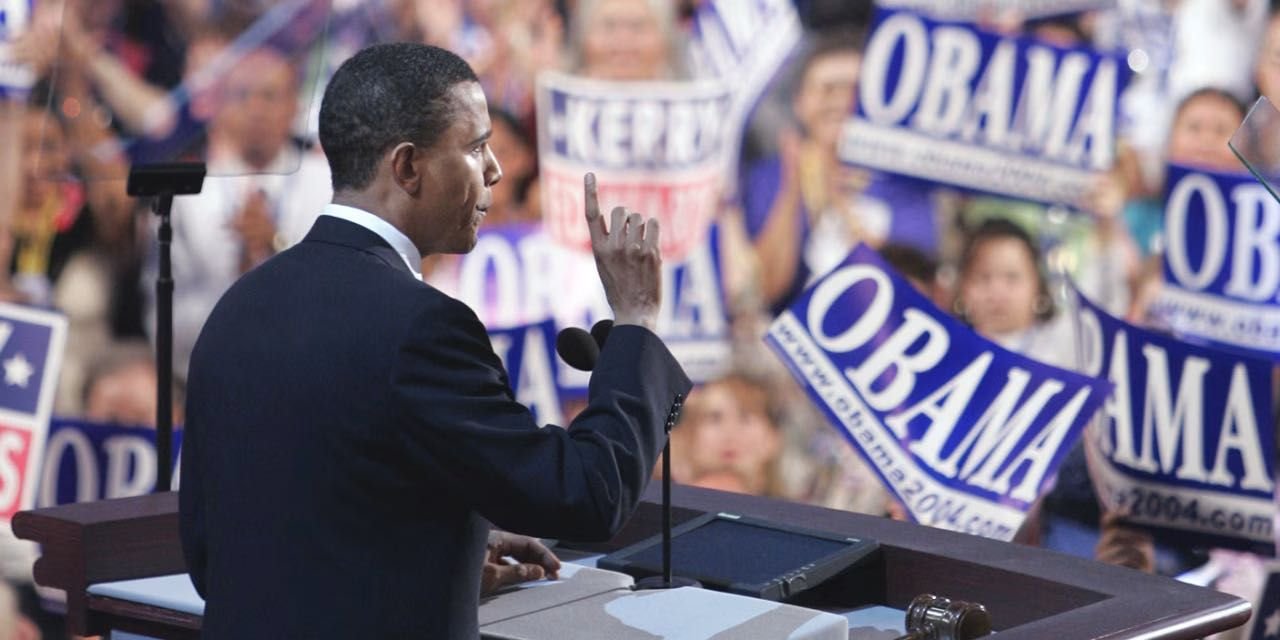
Barack Obama’s 2004 DNC Keynote Speech
Unit 3 English AOS 2 — Creating texts
Mentor text guide
Click on the image to watch the full speech.
Why is it a great mentor text?
On a thematic level, it is good to be inspired by Obama’s speech and how he writes a speech that expresses multiple frameworks seamlessly.
What’s impressive is how he effortlessly folds his own personal journey with common stories that are shared by American families, all whilst protesting a cynical approach to politics.
Obama doesn’t give a normal, boring speech. He employs literary devices effectively to convey a story about how his personal journey can only be successful in a country like America.
From personal anecdotes to repetition, Obama captivates his audience by vividly invoking imagery, transcending the realms of an ordinary speech.
Breaking down Obama's speech
•
Breaking down Obama's speech •
The opening
Delving into Obama’s personal journey and its relationship to country.
From the get-go, Obama smoothly incorporates two frameworks: personal journey and country. Interestingly, Obama remarks how his own personal journey is shaped by much of his parents’ respective stories. Hence, he also demonstrates how his parents’ personal journey is unified by country.
When reading the opening, take note a few things:
The short bursts of description and imagery that Obama utilises to convey his parents’ respective journeys;
How Obama depicts the story of a multicultural America by demonstrating two very different people who share a very similar journey, united by the “magical place” of America.
Obama’s protest
Obama outlines his vision for a fairer and united America. Obama makes several protests, mainly through the vehicles of repetitionand imagery.
Repetition
“There's not a black America and white America and Latino America and Asian America; there's the United States of America.”
Obama’s use of repetition
Obama liberally uses repetition. The function of a repetition is to not only emphasise an idea, but for the audience to take away a key message that is memorable.
Lines like “There's not a black America and white America and Latino America and Asian America; there's the United States of America.” became iconic, both vividly illustrating his vision for America whilst making a memorable protest.
“Whatever it is, the way you tell your story online can make all the difference.”
Imagery
Obama’s use of imagery
Obama strategically uses vivid imagery throughout his 2004 DNC address to visually convey his contention and strengthen his appeal to the audience. His imagery is carefully chosen to evoke empathy and create emotional resonance.
For instance, when he states, “the hope of a skinny kid with a funny name who believes that America has a place for him too,” Obama paints a humble, relatable picture of himself. By doing so, he invites the audience to empathise with his journey, presenting himself as a symbol of the broader American Dream.
This emotional connection reinforces his overarching message of unity and possibility.
Examples of repetition and imagery in Obama’s speech
Interestingly, Obama simualtanously employs both repetition and imagery. Here are some examples.
“If there's a child on the south side of Chicago who can't read, that matters to me, even if it's not my child. If there's a senior citizen somewhere who can't pay for her prescription and has to choose between medicine and the rent, that makes my life poorer, even if it's not my grandmother. If there's an Arab American family being rounded up without benefit of an attorney or due process, that threatens my civil liberties.”
“Well, I say to them tonight, there's not a liberal America and a conservative America - there's the United States of America. There's not a black America and white America and Latino America and Asian America; there's the United States of America.”
“It's the hope of slaves sitting around a fire singing freedom songs; the hope of immigrants setting out for distant shores; the hope of a young naval lieutenant bravely patrolling the Mekong Delta; the hope of a millworker's son who dares to defy the odds; the hope of a skinny kid with a funny name who believes that America has a place for him, too. The audacity of hope!”
How can you apply Obama’s techniques in your own creative piece?
Like Obama, define a character/s and their values and how they contextualise your own values.
Obama’s description of his parents is not about them or their personalities, but rather their journey and how he uses their stories to familiarise the audience with his parents
Obama’s storytelling is not complex, it is actually pretty simple. You do not need to overcomplicate your description with ‘fluff’. Effective storytelling is simple storytelling.








